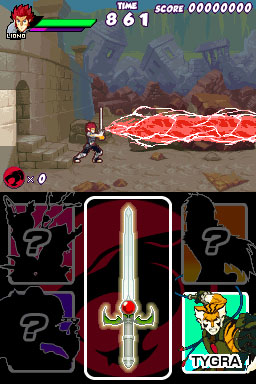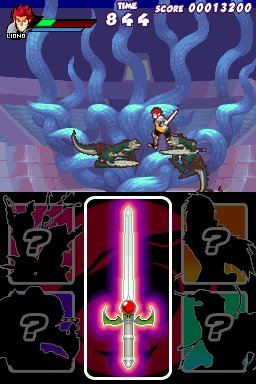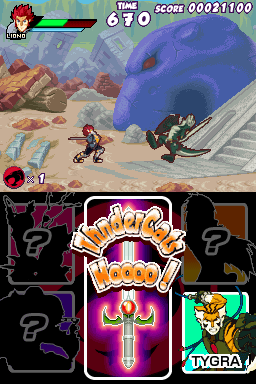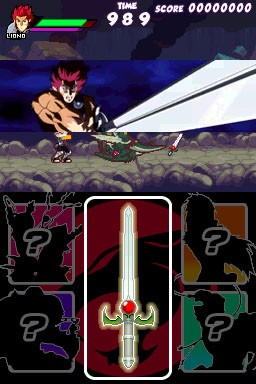Pretty artwork, decent music, cool special attacks
Archaic gameplay, clunky combo attack system, flawed save game system, storyline too truncated to be interesting
Thundercats for DS is a licensed title based on the Cartoon Network show of the same name, which in turn is a reboot of an iconic 1980s kids’ staple. The DS title essentially recaps elements of the reboot’s first season, but it does so in such a plain and flawed way that it makes it a difficult game to recommend for anyone but the most ardent fans of the new series.
The entirety of the game is side-scrolling, hack-and-slash combat. Players take control of the show’s headliner, Liono, as he battles his way through some of the events of season one. Liono naturally wields the Sword of Omens, but while most of the combat involves slashing away with basic variants on swordplay and combos, there are two varieties of special attacks as well. One involves charging up an energy bar to fire a horizontal energy blast from the sword’s eye, while the other requires collecting icons used to summon fellow ThunderCats like Tygra or Cheetara who can then unleash an attack or support ability.
The gameplay is retro at best, and archaic at its worst. Combat is a one-way side-scrolling affair with no opportunities to revisit areas on the left once they are off-screen, and character upgrades are limited to a few in-level power-ups that include health, summon icons, and a curious sword power-up that is mentioned no where in the barebones manual but presumably gives the sword more power. The game also operates on a points system that does little more than unlock some (admittedly pretty) concept art, all while a countdown timer runs at the top Super Mario Bros. style.


One consequence of this narrow, basic approach to gameplay is that the narrative is crippled. The story arc of the first season is a good one, ripe with character development and some really cool dramatic moments, but in the game all that drama is relegated to a few horribly generalized static storyboard sequences that seemed designed merely to connect the dots between combat stages.
Even as the sole obsession of the game, the combat feels lacking at times. Granted, the special attacks are cool and some of the swordplay is sort of fun, but irritants quickly become evident. For example, Liono’s claw shield is visibly present on his hand but he apparently has no use for it, as there is no actual guard action available; the only way to avoid incoming attacks is by jumping or using a rather uselessly short ground slide attack. The lack of a defense ability becomes especially aggravating with some of the mutants who wield high-power ranged rifles or the bosses whose far-reaching attacks are nearly impossible to evade.
The art of combat doesn’t always feel fluid, either. Combos are quite slow to develop for starters– once the attack button is pressed three times, Liono is committed for a bit of time. It’s quite easy to have the young warrior initiate a combo attack with wide cuts, only to be left vulnerable when those attacks miss (and attacks can miss thanks to hit detection that goes MIA if the player is too close to the target). One should not be surprised to make three mighty cuts right into an enemy only to hit nothing but air and then get smashed in the back of the head by an enemy for the trouble.


Another big problem relates to the way the game handles saves. There are six stages in the game, each divided up into a few sub-stages, but the game doesn’t really make this clear. There isn’t even any sort of indication when one stage ends and another begins, although the slightly longer cutscenes usually signal a new stage. Where this becomes a problem is if a player chooses to stop playing. In the in-level options menu there is a choice to “return to title screen” but clicking on it gives no warnings about lost progress. The game, however, only saves progress up to the point of the last completed full stage. A player might easily believe they have just finished a stage, only to discover that they had only completed a sub-stage, and when they return to play again they will have lost all of their progress– possibly two full sub-stages, or perhaps 10-15 minutes of playtime– without realizing it until they go back to continue the game.
The game at least looks and sounds pretty authentic. The cutscene and concept art stills are spot-on to the source material and look great, and the in-game characters are well-rendered. Combat, to its credit, runs at a steady frame rate. The music has some homages to the show and serves the purpose well enough, and while there is almost no voice acting save Liono shouting, the sound effects work well.
But the fact that it looks and sounds pretty good doesn’t change the basic fact that the game is, overall, a poor conception of a storied franchise. The design is basic and outmoded, and while in some games that can lend itself to a cool retro feel, it doesn’t feel that way here. A show based on its sense of adventure and personality has been reduced to a handful of repetitive side-scrolling stages that do a disservice to the franchise. Even in what it seeks to do, the game falters thanks to some combat problems and a poorly thought-out save system that will turn off adults and frustrate children. Thundercats for DS is a disappointing take on a promising reboot and is probably best avoided.
Nintendojo was provided a copy of this game for review by a third party, though that does not affect our recommendation. For every review, Nintendojo uses a standard criteria.




 ShareThis
ShareThis






